Social Psychology Chapter 7: Conformity
1/54
There's no tags or description
Looks like no tags are added yet.
Name | Mastery | Learn | Test | Matching | Spaced |
|---|
No study sessions yet.
55 Terms
Social Influence
The ways that people are affected by the real and imagined pressures of others.
- Social influence varies according to the degree of pressure exerted on the individual.
What are the three kinds of social influence?
Conformity
Compliance
Obedience
Continuum of social influence
Social influences vary in the degree of pressure they bring to bear on an individual. People may
(1) conform to group norms or maintain their independence,
(2) comply with requests or be assertive,
(3) obey or defy the commands of authority.

Social Influence as automatic
• As social animals, humans are vulnerable to subtle, almost reflex-like influences
- Animals exhibit rudimentary forms of automatic imitation
- Humans unwittingly mimic each other all the time
What does mimicry allow?
• people to interact and communicate more smoothly by influencing behaviors, emotions, and even language and speech styles
pg. 266
The Chameleon Effect
This graph shows the number of times per minute participants rubbed their face or shook their foot when they were with a confederate who was rubbing or shaking his foot.
pg. 267
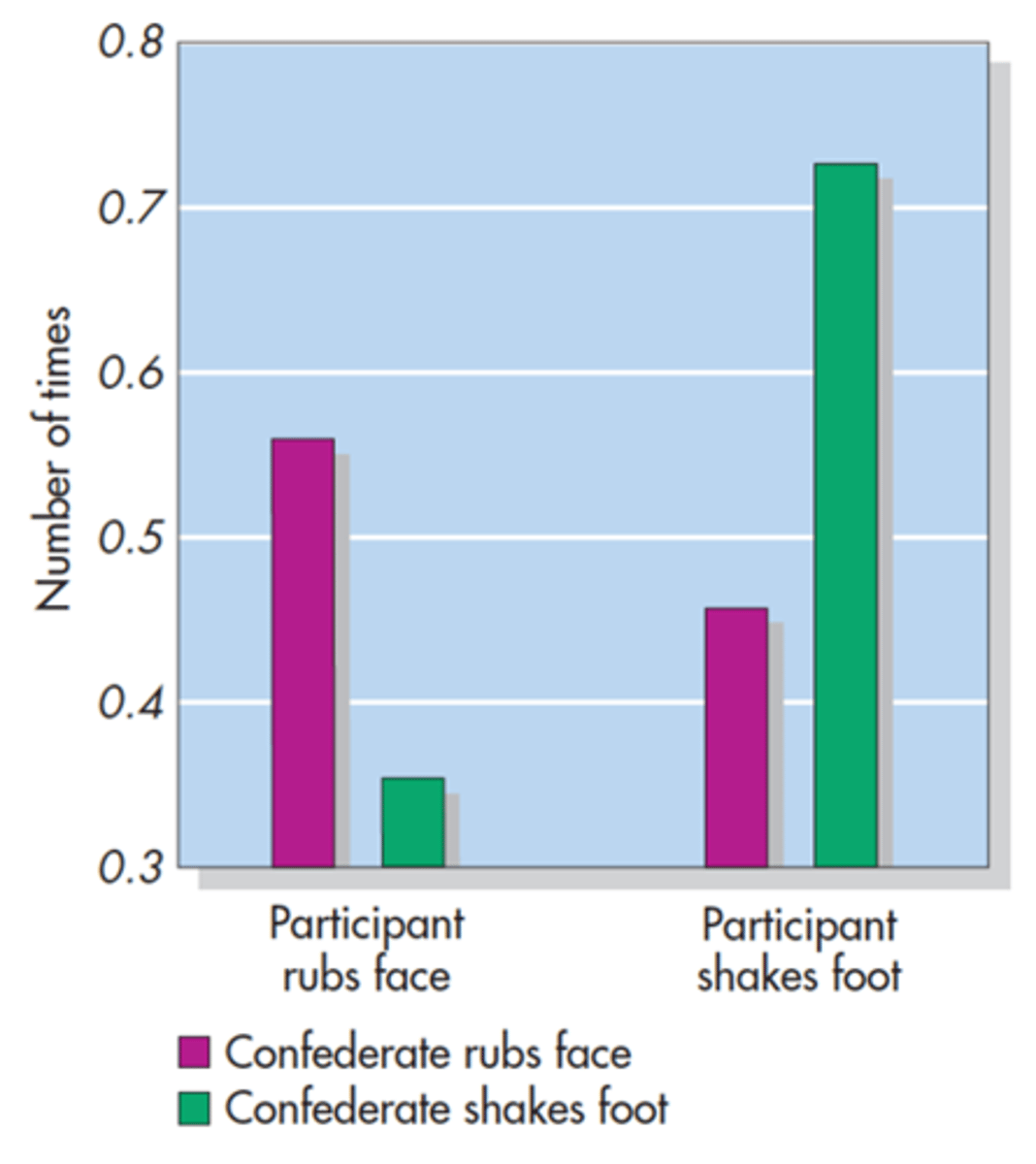
What is conformity?
• Tendency to change our perceptions, opinions, or behavior in ways that are consistent with group norms
Muzafer Sherif (1936) study
Optical illusion (autokinetic effect) used to test group norm development.
People think points of light move in the dark with no point of reference. On their own people came up with how far the point of light had moved. In groups of three they eventually reached a consensus. The light never moved.
- Participants turned to each other for guidance
- When faced with ambiguity and uncertainty about personal judgment, others can serve as a valuable source of information
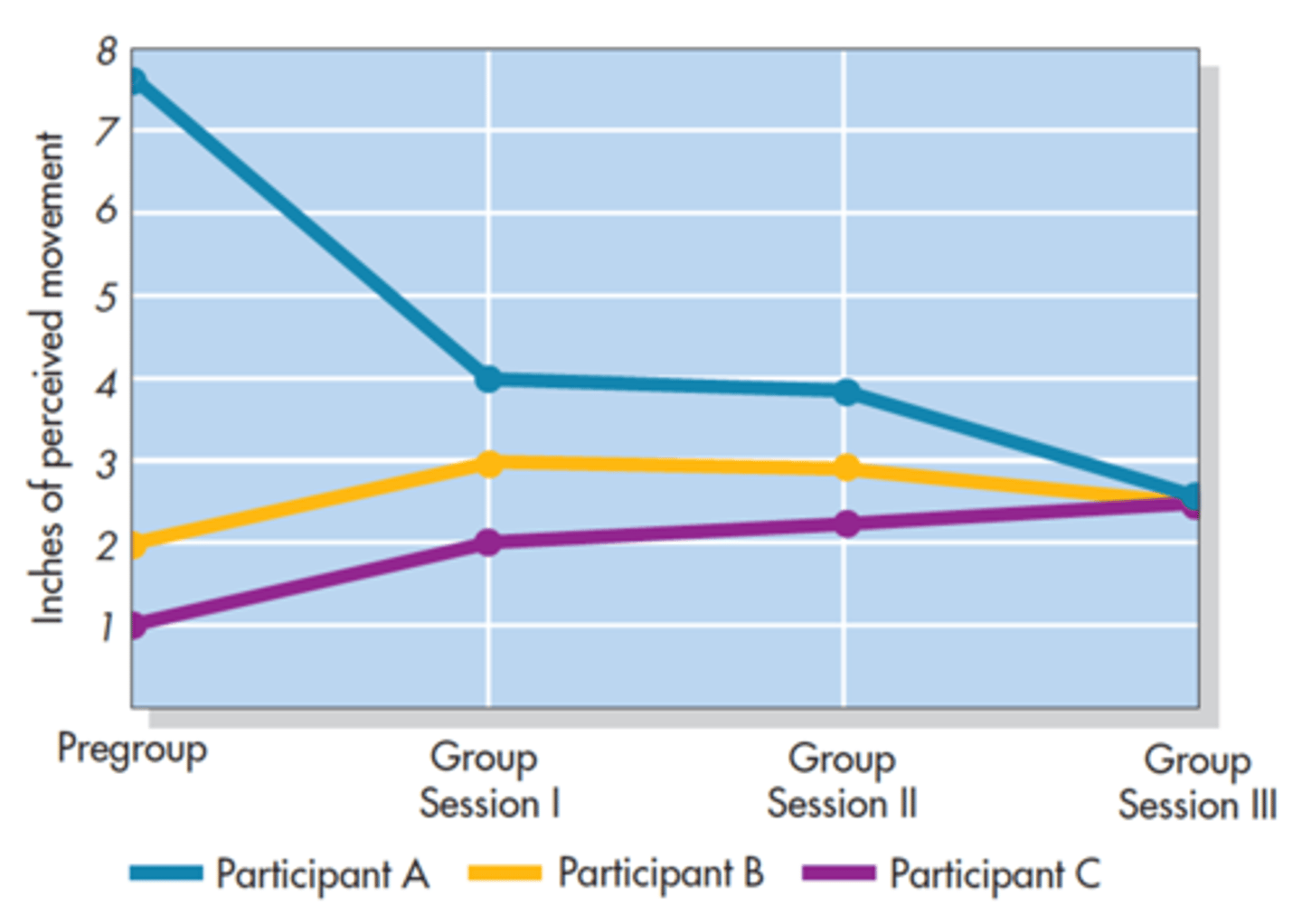
Solomon Asch (1951) study
line comparisons. If everyone (confeds) agree line is fictionally longer, participant more likely to agree with wrong answer.
Conformed to majority a third of the time.
• Confederates stated incorrect judgments for 12 of the 18 presentations
• Subjects conformed to the incorrect group judgment 37% of the time
- 50% went along at least half the time
- 25% refused to agree on any incorrect group judgments
- Remainder conformed on an occasional basis
-Participants felt they were in an awkward position
-People will sometimes conform, even when they are not convinced the group is right, to avoid feeling conspicuous, crazy, or like a misfit
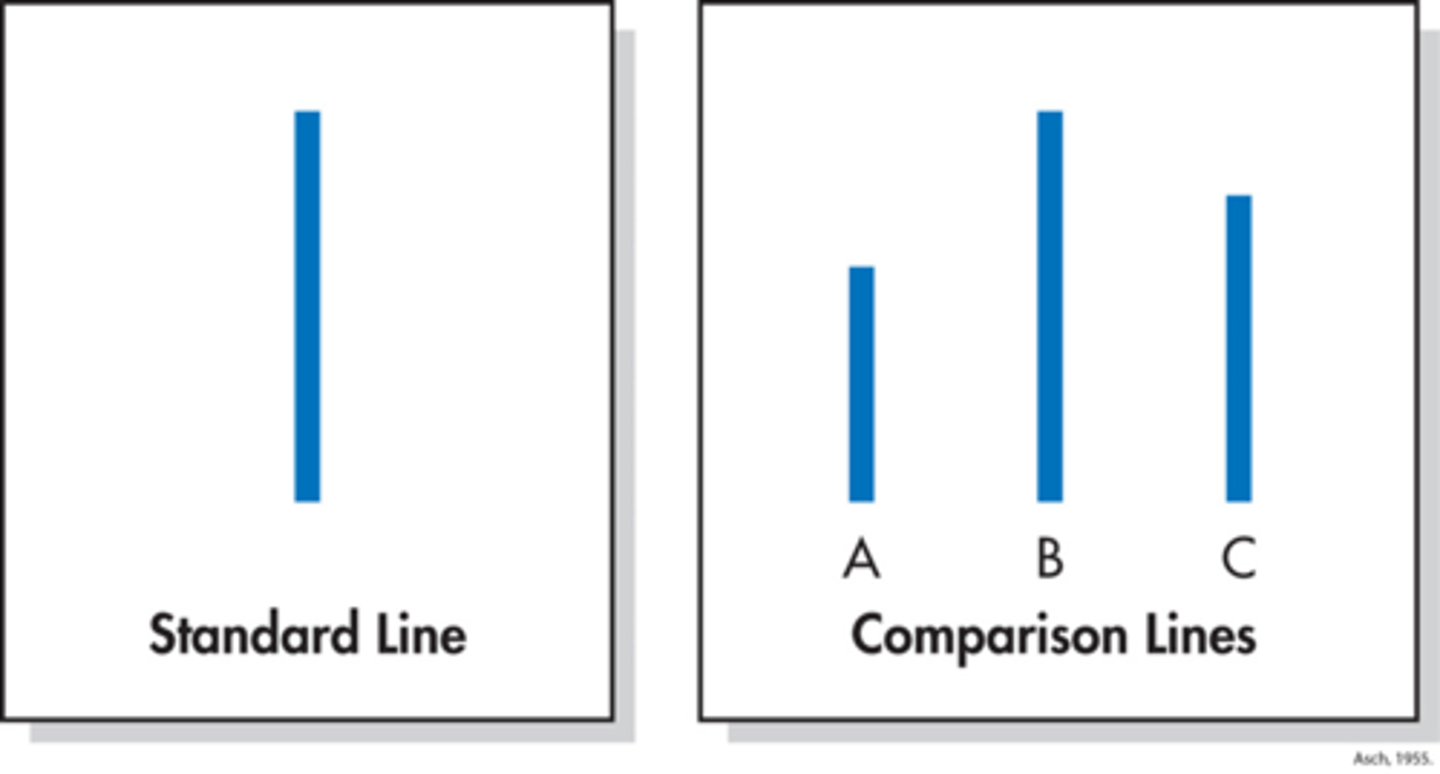
Why do people conform?
• Need to be right ( informational influence )
- Want to make good and accurate judgments of reality, and assume that when others agree on something, they must be right
• Fear of ostracism ( normative influence )
- Fear the consequences of rejection that follows deviance
Effects of social ostracism
• Being ostracized can cause emotional distress and lower self-esteem, and feelings of loneliness, being hurt, and anger
• Evolutionary scientists point to the human need for each other in order to survive
• Neural imaging indicates social pain of rejection produces activity in a part of the brain that is associated with physical pain
• Effect depends on source and cultural context
private conformity (acceptance)
true acceptance or conversion
Public conformity (compliance)
compliance; a superficial change in overt behavior without a corresponding change of opinion
What do fMRI studies suggest about group conformity?
• group conformity can result in changes in the brain that indicate altered perceptions, not just behavior
Conformity Effects on Perception
In this study, participants tried to determine if pairs of geometric objects were the same or different after observing the responses of four unanimous confederates. Participants followed the incorrect group 41% of the time. Suggesting that the group had altered perceptions, not just behavior, fMRI results showed that these conforming judgments were accompanied by increased activity in a part of the brain that controls spatial awareness. Berns et al., 2005
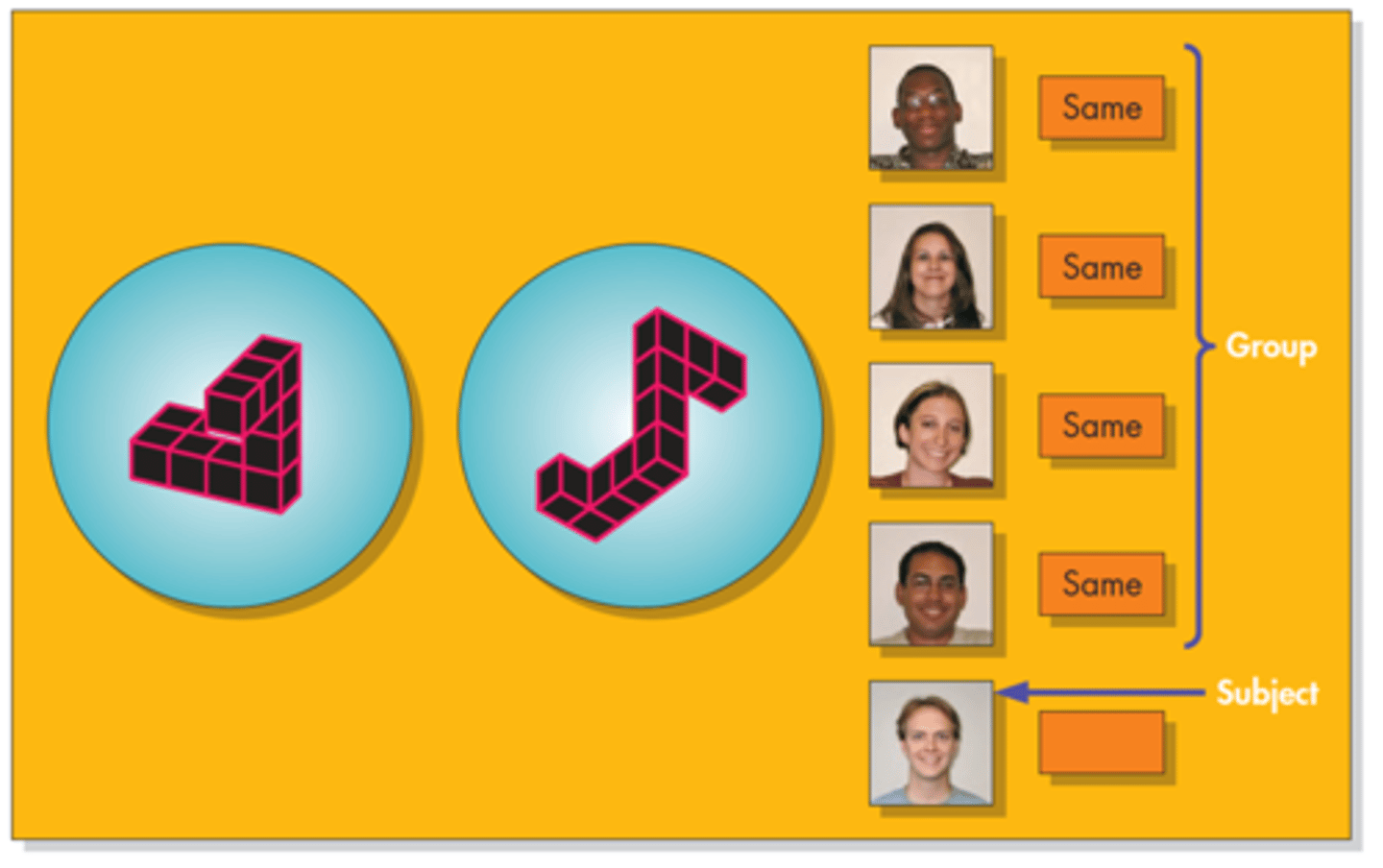
Distinguishing Types of Conformity
People made judgments under conditions in which they had a high or low level of motivation. Regardless of whether the judgment task was difficult or easy, there were moderate levels of conformity when participants had low motivation (left). But when they were highly motivated (right), participants conformed more when the task was difficult (as in Sherif's study) and less when it was easy (as in Asch's study). From Baron, R. et al.,
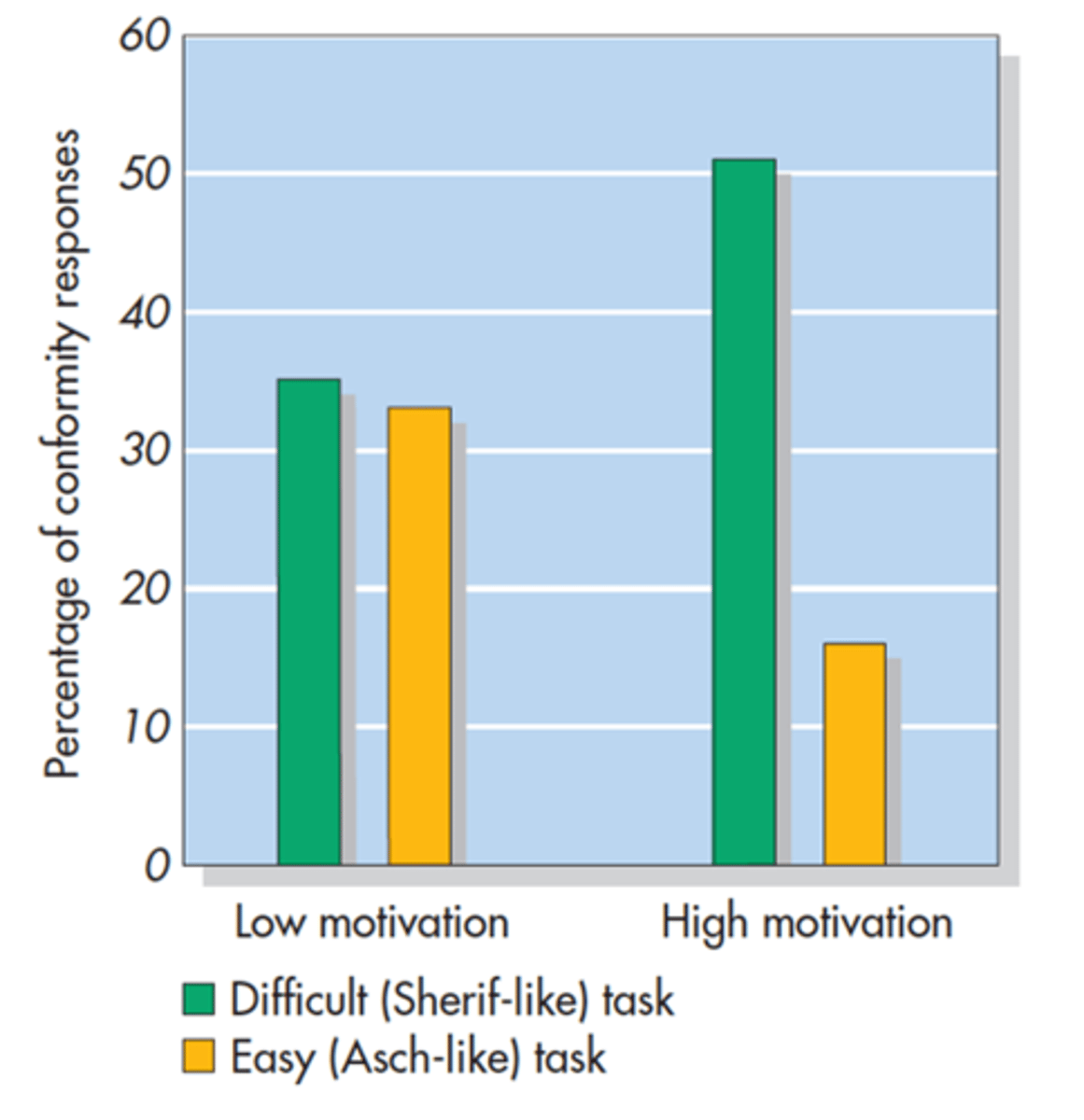
Two Types of Conformity
A comparison of Sherif's and Asch's studies suggests different kinds of conformity for different reasons. Sherif used an ambiguous task, so others provided a source of information and influenced the participants' true opinions. Asch used a task that required simple judgments of a clear stimulus, so most participants exhibited occasional public conformity in response to normative pressure but privately did not accept the group's judgments.
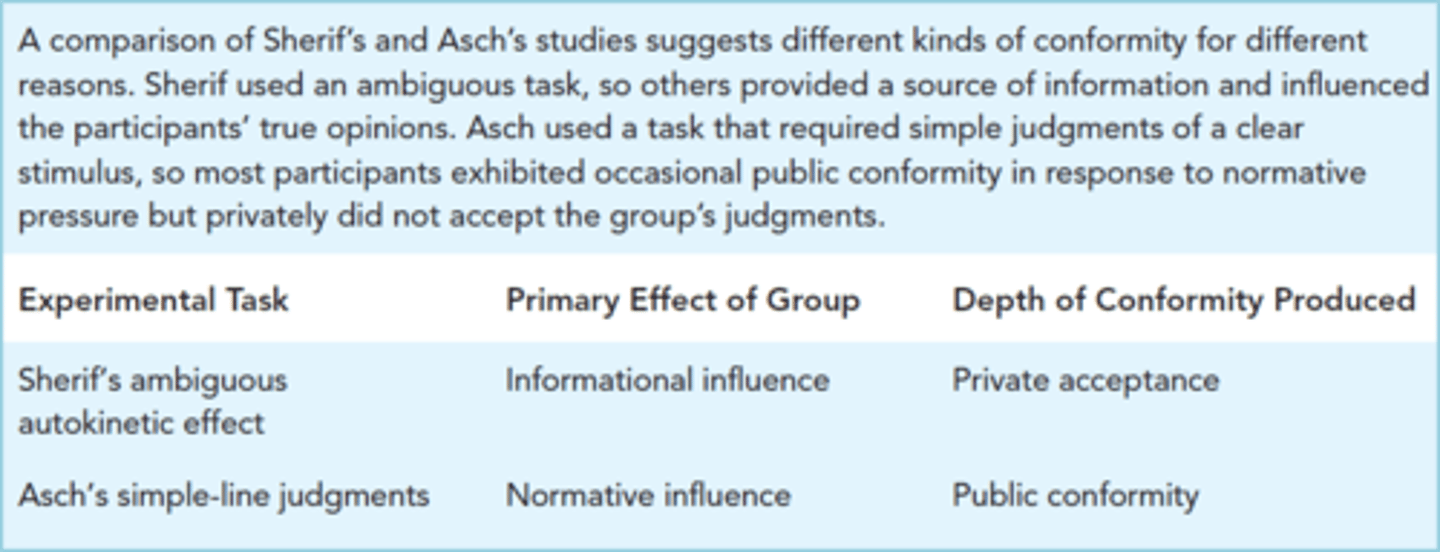
What is majority influence?
•Factors that influence feelings of pressure and insecurity that lead to conformity
– Group size
• Influence diminishes beyond 3 to 4 confederates
• We do more than count numbers, we try to assess the number of independent minds
– A focus on norms
• Social norms give rise to conformity only when we know the norms and they are “activated”
• Changing people’s perceptions about norms can change their behavior
– Having an ally in dissent
• A single confederate who agrees with a dissenter can reduce conformity (in the Asch studies, by almost 80%)
• Any dissent, whether it validates an individual’s opinion or not, can reduce normative pressures to conform
– Gender
• Familiarity with the issue affects conformity more than gender
• In public situations, women conform more and men conform less
On Being a Lone Dissenter: Voting Patterns on the U.S. Supreme Court
Out of 4,178 U.S. Supreme Court decisions handed down from 1953 to 2001, the 8-to-1 breakdown involving a lone dissenter was the least common type of vote. This historical observation is consistent with conformity research showing the power of the majority over an individual who lacks an ally.
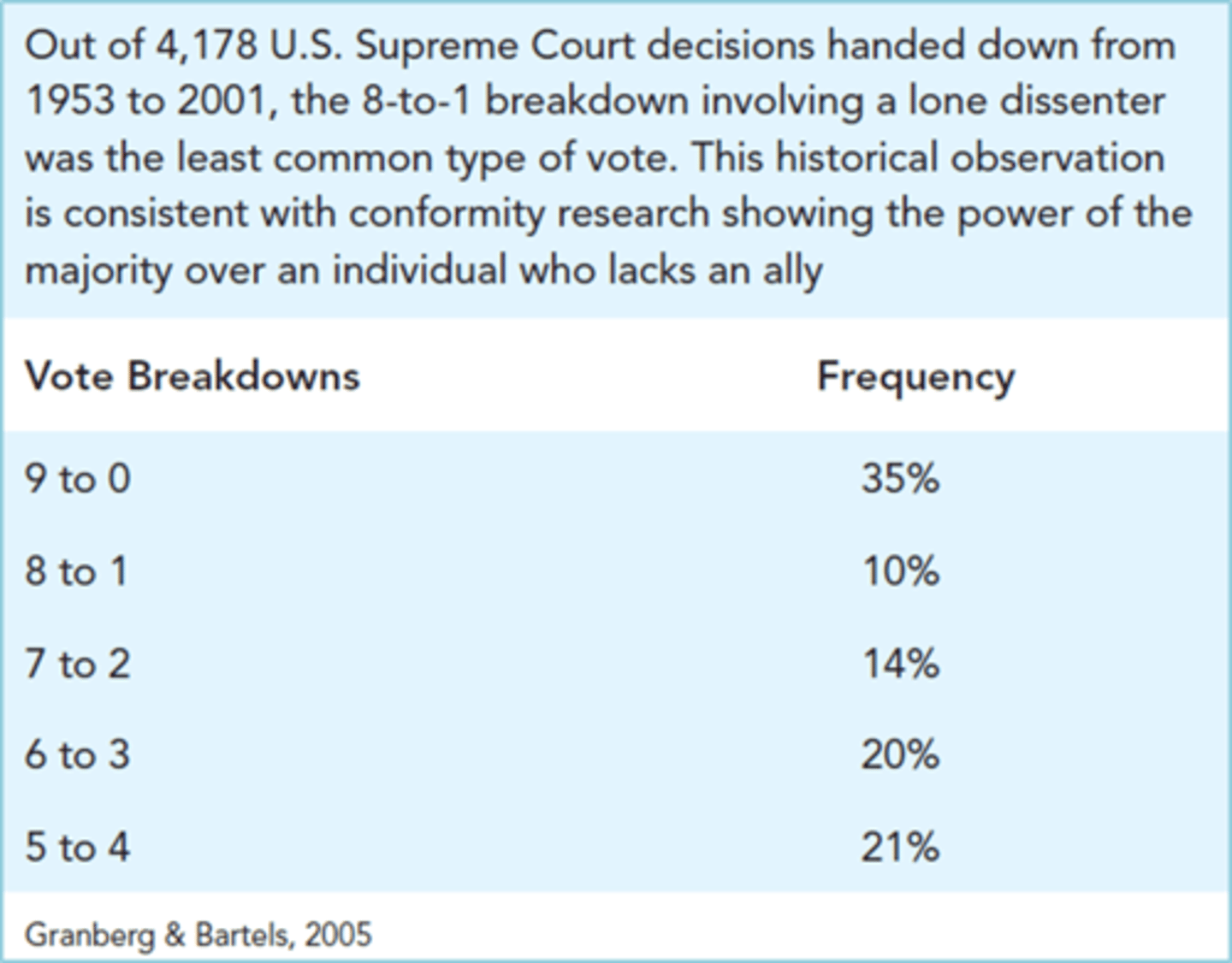
How are people with minority opinions viewed?
• People who assert beliefs contrary to the majority are generally seen as competent and honest, but are also disliked and rejected
How can nonconformists act as agents of social change?
By using strategies for exerting minority influence
- Minority influence: the process by which dissenters produce change within a group
What is Moscovici's theory of innovation and what does it recommend for effective dissent?
• Nonconformists derive power from the style of their behavior
• Minorities must be forceful, persistent, and unwavering in support of their position
– Must also appear flexible and open-minded
• Influence is greater when people identify with them in ways that are relevant and desirable
• Hollander’s alternative strategy: First conform, then dissent
pg. 278-279
Idiosyncrasy credits
Interpersonal "credits" that a person earns by following group norms.
Developed by Hollander
What are the two theories of how majorities and minorities create change?
Single process theory
- Both use the same process, ie., chip off the old block
Dual process theory
– Majorities elicit public conformity through stressful normative pressures on the individual
– Minorities elicit private conformity by leading others to become curious and rethink their original positions
Majorities have a greater impact on what?
Minorities have a greater impact on what?
Factual questions
Equal impact on opinion questions
When do majorities exert more influence?
When do minorities exert more influence?
When measured publicly, directly, and immediately
When measured directly or privately, when attitude issues are related but not focal to point of conflict, or after passage of time
Benefits of dissent
• Sparks innovation
• Forces other group members to think more carefully, openly, and in new and different ways
• Enhances the quality of a group's output
• Must be authentic dissent— playing devil's advocate bolsters a majority's position
Culture and conformity
• Cultures differ in the extent to which people adhere to social norms
• What determines whether a culture becomes individualistic or collectivistic?
- Complexity of the society: As industrialization progresses, there are more groups to be a part of
- Affluence of the society: As people prosper, they gain the means of independence and focus on personal goals.
- Heterogeneity of the society: Tight societies intolerant of those who veer from norm. Loose societies more permissive of dissent.
What is compliance?
• Changes in behavior that are elicited by direct requests
Mindlessness and Compliance
• People can be disarmed by the simple phrasing of a request
• How you ask for something can be more important than what you ask for
• We often comply mindlessly to requests without fully processing the information the words convey
• Disrupting mindlessness can also increase compliance
What does the Norm of Reciprocity dictate?
That we treat others as they have treated us
- Leads us to feel obligated to repay acts of kindness, even when unsolicited
- Can also be used to sanction retaliation against those who have caused us harm
• Norm of reciprocity is relatively short-lived, at least for small acts of kindness
Would You Accept the Offer?
People from China and Canada rated the likelihood that they would accept a free sample of soup in a supermarket (left) or a free drink from a casual friend at an airport (right). Feeling a greater burden to reciprocate, Chinese participants in both cases said they were less likely to accept the gift. Shen et al., 2011
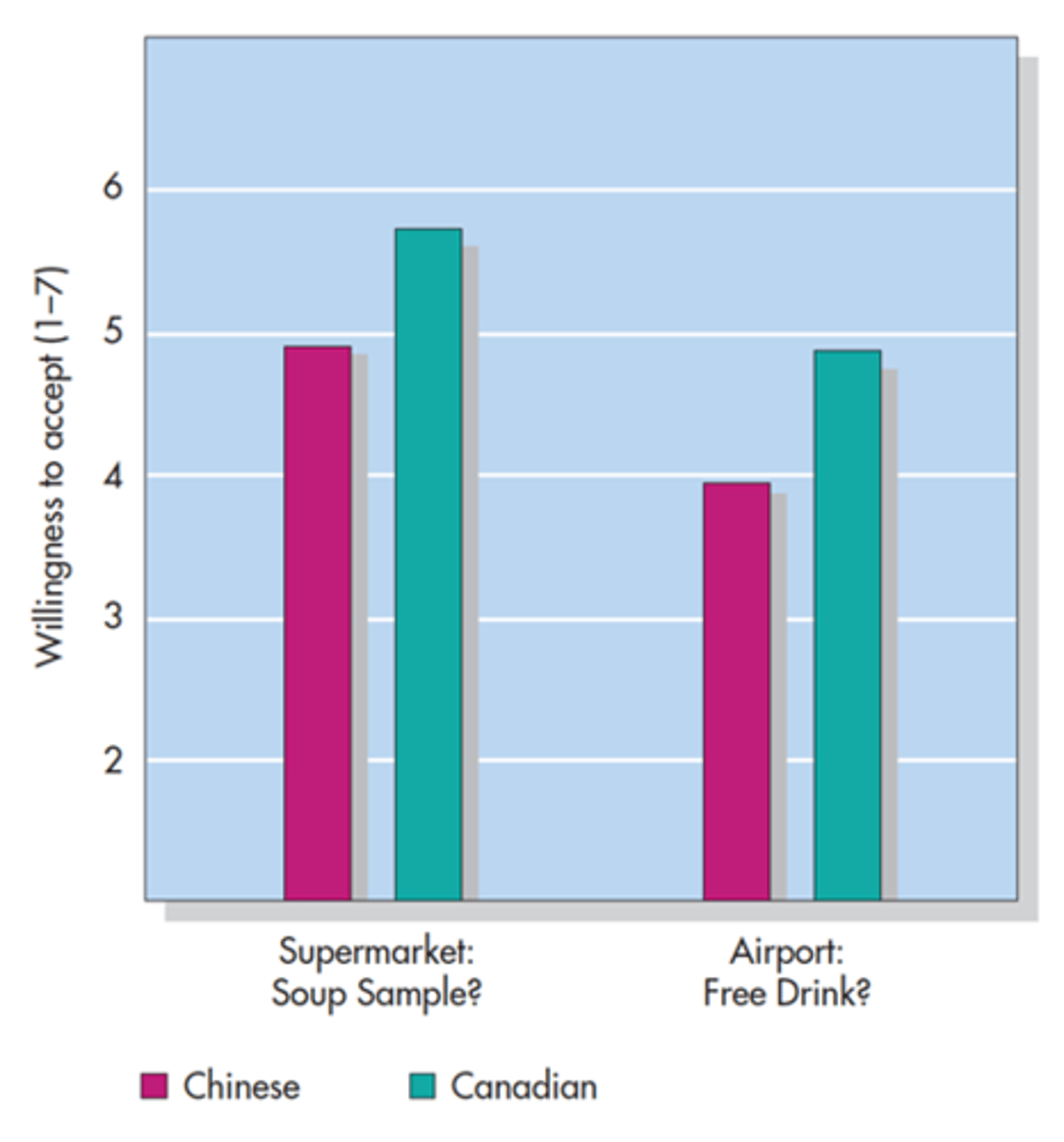
Sequential Request Strategies
foot in the door, lowballing,
door in the face,
that's not all
The foot-in-the-door technique
Two-step compliance technique in which an influencer sets the stage for the real request by first getting a person to comply with a much smaller request
Lowballing
Two-step compliance technique in which the influencer secures agreement with a request but then increases the size of the request by revealing hidden costs
The door-in-the-face technique
Two-step compliance technique in which an influencer prefaces the real request with one that is so large that it is rejected
That's-not-all technique
Two-step compliance technique in which the influencer begins with an inflated request, then decreases its apparent size by offering a discount or bonus
Sequential Request Strategies chart
Small to large
Large to small
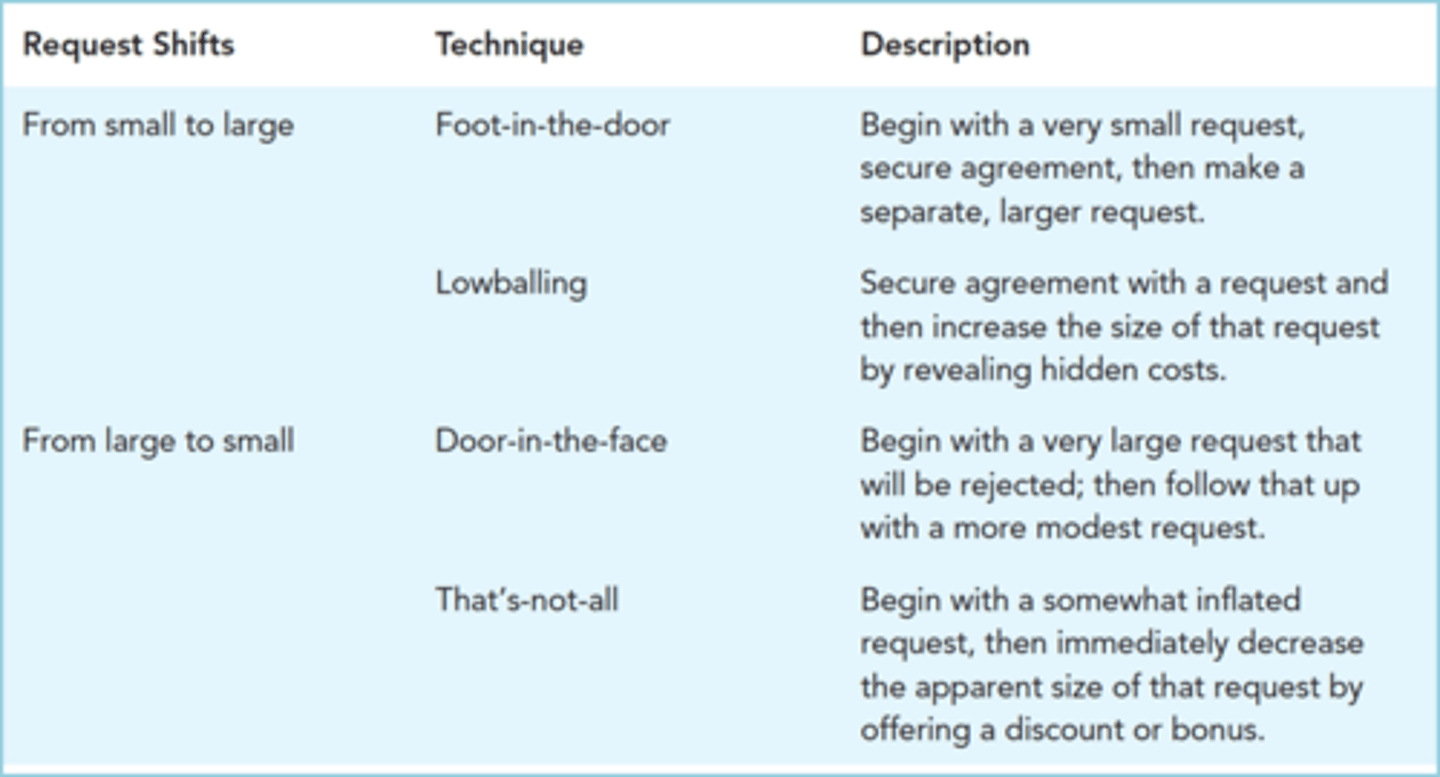
How are compliance strategies resisted?
- Be vigilant
- Do not feel indebted by the norm of reciprocity
- Recognize when these tactics are being used and respond accordingly
Compliance techniques work smoothly only if they are hidden from view
What is obedience?
• Behavior change produced by the commands of authority
• May also be obtained by the symbols of authority, even without the necessary credentials
- Titles, uniforms, badges, and the trappings of success
Why is Milgram's experiment subject of much ethical debate?
- Potential psychological harm to participants
- Profound contribution to our understanding of human nature and an important social problem
Learner's protests to Milgram experiments
As participants administered progressively more intense shocks, they heard the learner moan, groan, protest, and complain. All participants heard the same programmed set of responses. Eventually, the learner fell silent and ceased to respond.
pp 42
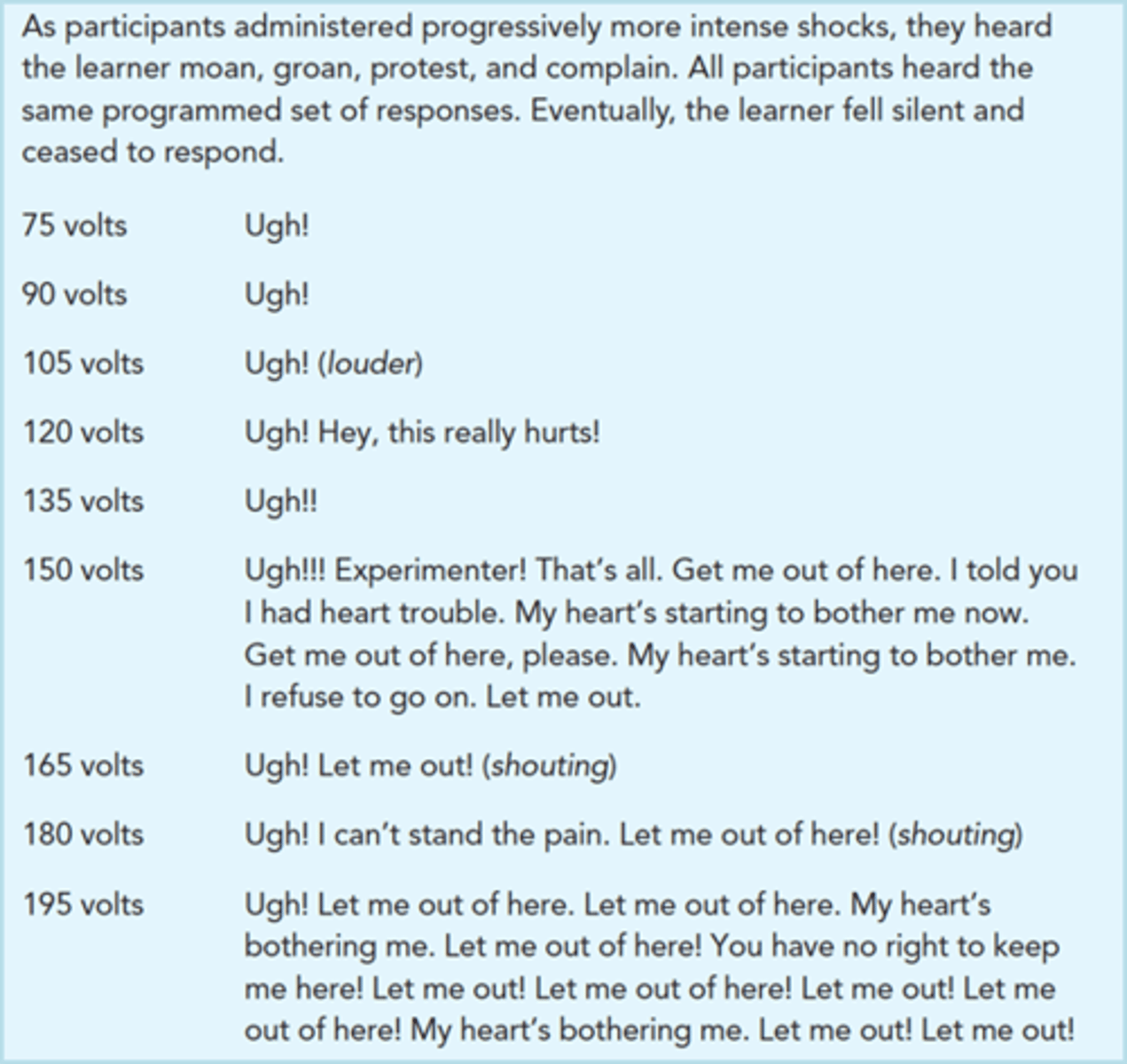
What did Milgram's group predict?
• On average, groups Milgram interviewed predicted they would stop at the 135-volt level
– Psychiatrists, college students, and middle-class adults
• No one thought he or she would go all the way to 450 volts
• Similar predictions that other people would not deliver the maximum shock
What degree of obedience did Milgram's study produce?
• Study involved 40 men from New Haven area
- Administered an average of 27 out of 30 possible shocks
- 26 of the 40 participants—65%—delivered the maximum 450 volts
- Control group participants who were not prodded by the experimenter refused to continue early in the shock sequence
• No gender difference; replication with 40 women showed same results (65% gave the full 450 volts)
• Milgram's basic findings have been replicated in several different countries and among different age groups
Does an individual's character make a difference in terms of obedience?
Yes
• F-Scale: authoritarian personality
-People with high F-Scale scores are rigid, dogmatic, sexually repressed, ethnocentric, intolerant of dissent, and punitive
-Submissive toward figures of authority but aggressive toward subordinates
• Milgram was able to identify factors that increase and decrease the rate of obedience
Factors that Influence Obedience
Milgram varied many factors in his research program. Without commands from an experimenter, fewer than 3% of the participants exhibited full obedience. Yet in the standard baseline condition, 65% of male and female participants followed the orders. To identify factors that might reduce this level, Milgram varied the location of the experiment, the status of the authority, the participant's proximity to the victim, and the presence of confederates who rebel. The effects of these variations are illustrated here. Milgram, 1974

Factors: The authority figure in Milgram's experiment
- Destructive obedience required the physical presence of a prestigious authority figure
- Reducing the experimenter's apparent status also reduced obedience to 48%
- Replacing the experimenter with a regular person (supposedly another participant) reduced obedience to 20%
Factors: The victim in Milgram's experiment
- Situational characteristics of the victim are important factors in destructive obedience
- Being seated next to the victim reduced obedience to 40%
- Having to force the victim's hand onto a shock plate reduced obedience to 30%
- Obedience was only 15% if the victim had a prior relationship with the victim (unpublished experiment)
Factors: Elements of the Procedure
- Participants were led to feel relieved of personal responsibility for the victim's welfare
- Gradual escalation in small increments was used
- The situation was novel, with unknown norms
- The task was quickly paced, preventing participants from considering their values and options, thinking about possible consequences, or making careful decisions
Meeus and Raaijmakers 1995 experiment
In which participants were ordered to cause psychological harm
- Harass a job applicant taking a test during a job interview
• When the "applicant" pleaded with the participant to stop
- In control group, no one continued
- In experimental group, 92% exhibited complete obedience when prodded by experimenter
Obedience in the Twenty-First Century
In the version of the experiment that Burger modeled, 83% of Milgram's original participants continued past 150 volts. Forty-five years later, Burger saw a slight drop to 70%. Note too that the obedience rate dropped only slightly, to 63%, among participants who saw a defiant confederate refuse to continue. These results show that obedience to authority may have declined a bit over the years, but it has by no means Extinguished. Burger, 2009
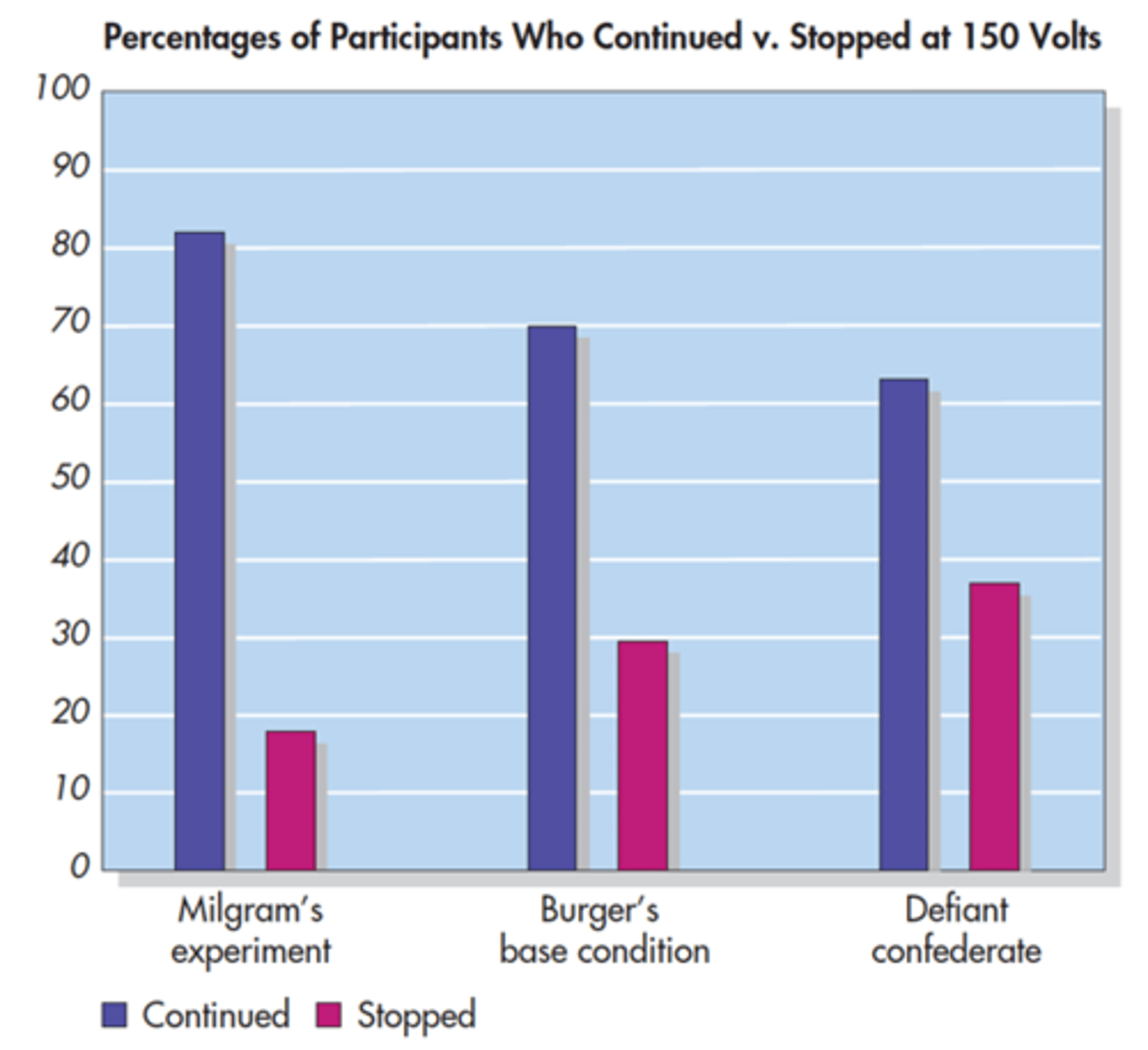
Why did Milgram's participants follow orders?
Caught up in momentum, not blind, but obedience nonetheless.
Or, engaged followership: subjects identify with scientific enterprise and wanted to make contribution and help experimenter.
pg. 300, 301
Defiance
• Social influence can also breed rebellion and defiance
• Synchrony of behavior can have a unifying effect on people, increasing their tendency to follow what others are doing
• Having allies can give individuals the courage to resist orders they find offensive
Social influence depends on what three factors
- The strength of the source
- The immediacy of the source to the target in time and space
- The number of sources
Social Impact: Source and Target Factors
Factors According to social impact theory, the total influence of other people, or “sources,” on a target individual depends on three source factors: their strength (size of source circles), immediacy (distance from the target), and number (number of the source circles). Similarly, the total influence is diffused, or reduced, by the strength (size of target circles), immediacy (distance from source circle), and number of target persons. From Latane, B.,
